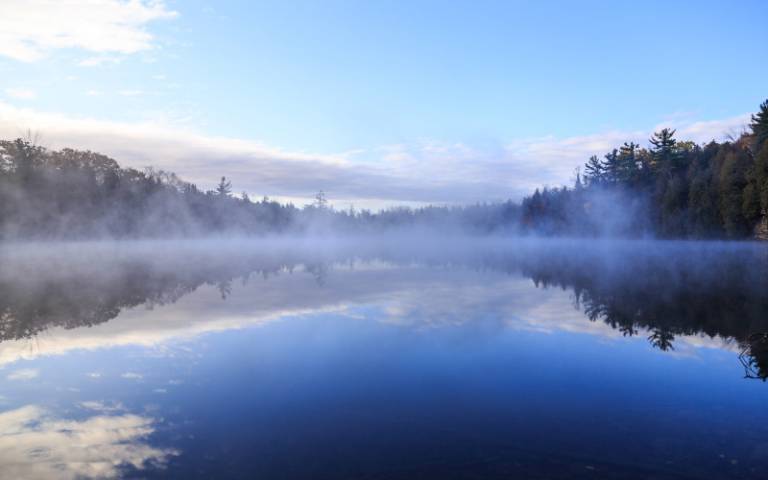Spot marking the beginning of the Anthropocene identified by UCL researchers
14 July 2023
A Canadian lake has been proposed as the official point marking the onset of the Anthropocene period by a committee led by a UCL academic.

The Anthropocene is a proposed geological time period starting in the 1950s, defined by the impact of human activity on Earth.
The term “Anthropocene” has been informally used by scientists for some time to refer to the modern era, but defining the point in time through observed geologic processes is an important step to officially recognising it as a new epoch in Earth’s geologic timeline. This new age has been ushered in by unprecedented changes in Earth’s climate and environment, stemming from the dramatic increases in industrial and socioeconomic activity since the mid-twentieth century. It would mark the end of the previous epoch, the Holocene, a period of relatively stable climate conditions that started about 11,700 years ago.
Researchers from the Anthropocene Working Group nominated the sedimentary layers at the bottom of Crawford Lake near Toronto, Canada, to be recognized as the Global boundary Stratotype Section and Point (GSSP) marking the beginning of the Anthropocene. These reference points are used by scientists to mark the boundaries between geological time units and indicate periods of planetary change.
Secretary of the Anthropocene Working Group, Dr Simon Turner (UCL Geography) said: “The sediments found at the bottom of Crawford Lake provide an exquisite record of recent environmental change over the last millennium. Seasonal changes in water chemistry and ecology have created annual layers that can be sampled for multiple markers of historical human activity.
“It is this ability to precisely record and store this information as a geological archive that can be matched to historical global environmental changes which makes sites such as Crawford Lake so important. A GSSP is used to correlate similar environmental changes seen in other sites worldwide, so it is critical to have a robust and reproducible record at this type of locality.”
Cores of the sedimentary layers at the bottom of Crawford Lake illustrate a distinct, annual record dating back centuries. With detailed annual resolution, the sediments record shifts in the natural environment, evidence of indigenous agriculture and early industrial level logging in the region.
However, the researchers said that the most significant shifts are from the human-made markers embedded within them, dating to the mid-twentieth century. These markers include fallout from nuclear tests, plastic particles, dramatic changes to the local ecosystems, and particles from fossil fuel combustion and other pollutants.
Professor Andrew Cundy, Chair in Environmental Radiochemistry at the University of Southampton and member of the Anthropocene Working Group, said: “The presence of plutonium gives us a stark indicator of when humanity became such a dominant force that it could leave a unique global ‘fingerprint’ on our planet. In nature, plutonium is only present in trace amounts. But in the early 1950s, when the first hydrogen bomb tests took place, we see an unprecedented increase and then spike in the levels of plutonium in core samples from around the world. We then see a decline in plutonium from the mid-1960s onwards when the Nuclear Test Ban Treaty came into effect.”
Researchers at the UCL Department of Geography have been central in identifying and characterising the radionuclides and combustion particles taken from the sedimentary cores.
Whilst Crawford Lake is not the only place to experience these planet-wide changes, its nomination represents the fact that it’s home to one of the clearest and best-defined geological records of them.
The nomination of the location is the first step in a lengthy process before the site becomes the official marker, and there’s no guarantee that the proposal will succeed. The proposal now needs to be agreed upon and voted in by the full Anthropocene Working Group. It then requires adoption by the Subcommission on Quaternary Stratigraphy followed by the International Union of Geological Sciences for final ratification.
The Anthropocene Working Group is an interdisciplinary research group dedicated to the investigation of the Anthropocene as a geological unit of time set up by the International Commission on Stratigraphy. Since 2019, the group had been studying numerous different locations across the globe looking for the best location to mark the beginning of the Anthropocene.
The Anthropocene Working Group’s efforts are supported in conjunction with the Haus der Kulturen der Welt in Berlin, and the Max Planck Institute for the History of Science.
Links
- Anthropocene Working Group
- Dr Simon Turner's academic profile
- UCL Geography
- UCL Social & Historical Sciences
Image
- Lake Crawford, Credit: Anthropocene Working Group
Media Contact
Mike Lucibella
- E: m.lucibella [at] ucl.ac.uk
 Close
Close

